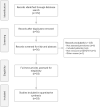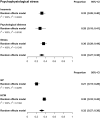Mental Health in COVID-19 Pandemic: A Meta-Review of Prevalence Meta-Analyses
- PMID: 34621212
- PMCID: PMC8490780
- DOI: 10.3389/fpsyg.2021.703838
Mental Health in COVID-19 Pandemic: A Meta-Review of Prevalence Meta-Analyses
Abstract
Background: Mental health burden has been massively reported during the COVID-19 pandemic period. Aiming to summarise these data, we present a meta-review of meta-analyses that evaluated the impact of COVID-19 pandemic on anxiety, depressive and stress symptoms, psychological distress, post-traumatic stress disorder/symptoms (PTSD), and sleep disturbance, reporting its prevalence on general public (GP) and health care workers (HCW). Methods: A search was performed in the PubMed, EMBASE, and the Web of Science. Sleep disturbances, psychological distress, stress, and burnout were grouped as "Psychophysiological stress," and anxiety, depression, and PTSD were grouped as "Psychopathology." A random-effects model, calculating the pooled prevalence together with 95% confidence interval was performed for each domain. Subgroup analyses were performed for each population type (GP and HCW) and for each mental health outcome. For anxiety and depression, subgroup analysis for population type was performed. Heterogeneity is reported as I 2. Publication bias was assessed through visual inspection of the funnel plot, and further tested by Egger's test and trim and fill analyses. Results: A total of 18 meta-analyses were included. The prevalence of psychophysiological stress was 31.99% (CI: 26.88-37.58, I 2 = 99.9%). HCW showed a higher prevalence (37.74%, CI: 33.26-42.45, I 2 = 99.7%) than the GP (20.67%, 15.07-27.66, I 2 = 99.9%). The overall prevalence of insomnia, psychological distress, and stress were, respectively, 32.34% (CI: 25.65-39.84), 28.25% (CI: 18.12-41.20), and 36% (CI: 29.31-43.54). Psychopathology was present at 26.45% (CI: 24.22-28.79, I 2 = 99.9%) of the sample, with similar estimates for population (HCW 26.14%, CI: 23.37-29.12, I 2 = 99.9%; GP: 26.99%, CI: 23.41-30.9, I 2 = 99.9%). The prevalence of anxiety, depression, and PTSD was 27.77% (CI: 24.47-31.32), 26.93% (CI: 23.92-30.17), and 20% (CI: 15.54-24.37), respectively. Similar proportions between populations were found for anxiety (HCW = 27.5%, CI: 23.78-31.55; GP = 28.33%, CI: 22.1-35.5) and depression (HCW = 27.05%, CI: 23.14-31.36; GP = 26.7%, CI: 22.32-31.59). Asymmetry in the funnel plot was found, and a slight increase in the estimate of overall psychopathology (29.08%, CI: 26.42-31.89) was found after the trim and fill analysis. Conclusions: The prevalence of mental health problems ranged from 20 to 36%. HCW presented a higher prevalence of psychophysiological stress than the general population. Systematic Review Registration:https://www.crd.york.ac.uk/PROSPERO/display_record.php?RecordID=252221, identifier: CRD42021252221.
Keywords: COVID-19; anxiety; depression; general public; healthcare worker.
Copyright © 2021 Sousa, Tavares, de Meiroz Grilo, Coelho, Lima-Araújo, Schuch and Galvão-Coelho.
Conflict of interest statement
The authors declare that the research was conducted in the absence of any commercial or financial relationships that could be construed as a potential conflict of interest.
Figures



References
Publication types
LinkOut - more resources
Full Text Sources
Medical

